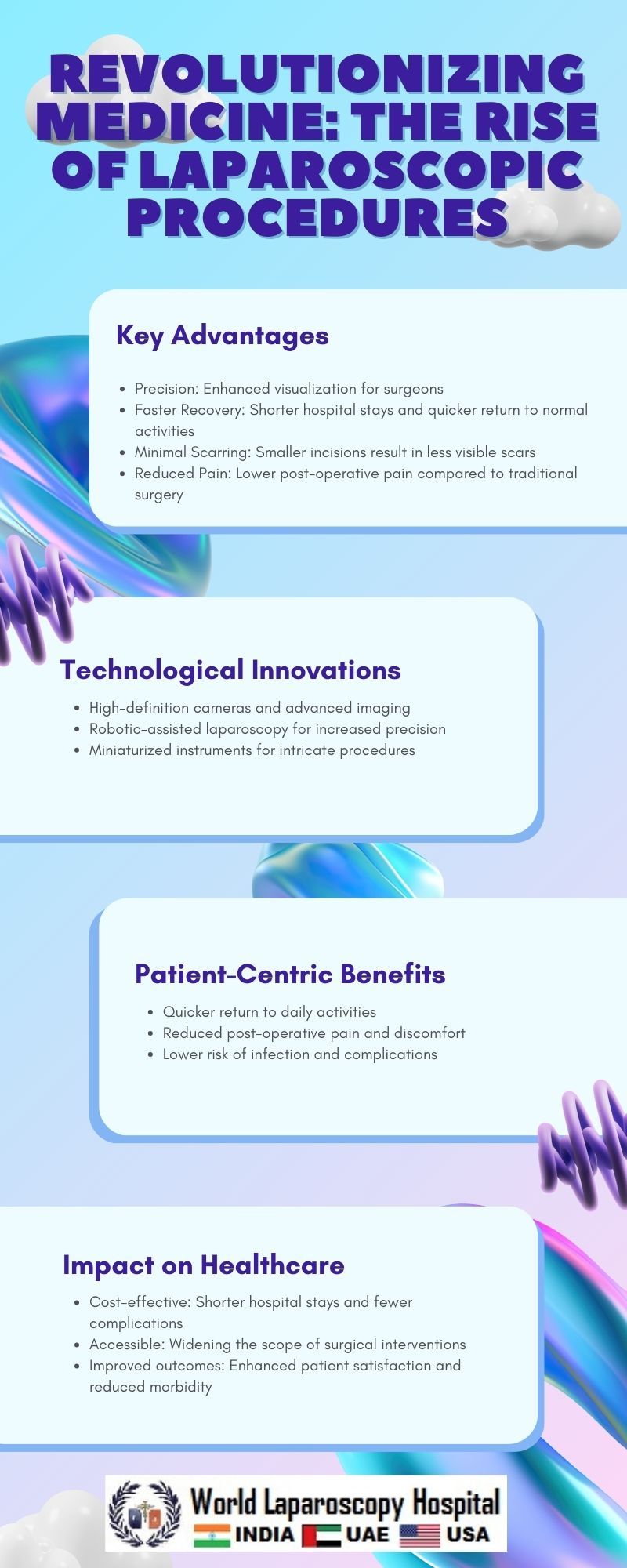Revolutionizing Medicine: The Rise of Laparoscopic Procedures
Introduction:
In the ever-evolving landscape of medical advancements, laparoscopic procedures have undeniably emerged as a revolutionary force. This transformative approach to surgery has reshaped the way medical professionals approach various conditions, offering patients a less invasive yet highly effective alternative to traditional open surgeries. This article explores the multifaceted dimensions of laparoscopic procedures, tracing their historical roots, examining their technical intricacies, and delving into the myriad benefits they bring to both patients and healthcare providers.

Historical Evolution:
The roots of laparoscopic surgery can be traced back to the early 20th century when the first attempts were made to visualize the abdominal cavity using rudimentary instruments. However, it was not until the latter half of the century that technological advancements paved the way for the development of the laparoscope—a tubular instrument equipped with a light source and camera. The watershed moment came in 1987 when French surgeon Dr. Phillipe Mouret performed the world's first laparoscopic cholecystectomy, removing a gallbladder through small incisions. This groundbreaking procedure marked the beginning of a new era in surgery.
Technical Advancements:
Laparoscopic procedures are characterized by the use of small incisions through which a laparoscope and specialized instruments are inserted. The laparoscope, equipped with a high-resolution camera, provides real-time imaging of the internal organs on a monitor, allowing surgeons to navigate and perform intricate procedures with precision. Advancements in optics, miniaturization of instruments, and the integration of robotic technology have further enhanced the capabilities of laparoscopic surgery.
Various Laparoscopic Procedures:
Laparoscopic techniques have expanded to encompass a wide array of surgical procedures across different medical specialties. In the field of general surgery, laparoscopic cholecystectomy, appendectomy, and hernia repairs have become routine. Gynecologists employ laparoscopy for procedures such as hysterectomy and ovarian cyst removal. In urology, conditions like kidney and prostate surgeries are increasingly being approached laparoscopically. Orthopedic surgeons also utilize this technique for joint surgeries. The versatility of laparoscopic procedures is a testament to its adaptability and effectiveness.
Benefits to Patients:
One of the primary advantages of laparoscopic procedures is the minimization of trauma to the body. Traditional open surgeries often involve large incisions, leading to increased pain, longer recovery times, and a higher risk of complications. In contrast, laparoscopic surgeries typically require smaller incisions, resulting in reduced postoperative pain, shorter hospital stays, and faster recovery. Additionally, the cosmetic outcomes are generally more favorable, as the scars are smaller and less noticeable.
Reduced Blood Loss:
Laparoscopic procedures are associated with significantly reduced blood loss compared to open surgeries. The precision afforded by the laparoscope and specialized instruments allows for meticulous control of blood vessels, minimizing the need for extensive suturing and decreasing the risk of complications related to excessive bleeding. This benefit is particularly crucial in surgeries involving highly vascular organs or structures.
Faster Recovery and Shorter Hospital Stays:
The minimally invasive nature of laparoscopic procedures translates into faster recovery times for patients. The smaller incisions result in less tissue damage, enabling individuals to resume normal activities more quickly than those undergoing traditional open surgeries. Moreover, the shorter hospital stays associated with laparoscopy contribute to cost-effectiveness and reduced strain on healthcare resources.
Lower Infection Rates:
The risk of postoperative infections is lower in laparoscopic procedures compared to open surgeries. The reduced exposure of internal organs to the external environment, along with the smaller incisions, minimizes the entry points for bacteria. This lower risk of infection is a critical factor in improving overall patient outcomes and reducing the need for prolonged antibiotic use.
Improved Visualization and Precision:
The laparoscopic camera provides surgeons with a magnified and illuminated view of the surgical site, enhancing visualization compared to the naked eye in open surgery. This heightened visibility allows for greater precision in manipulating tissues and performing intricate procedures. Surgeons can navigate through complex anatomical structures with better accuracy, reducing the likelihood of inadvertent damage to surrounding tissues.
Challenges and Considerations:
While laparoscopic procedures offer numerous benefits, they are not without challenges. Surgeons must undergo specialized training to master the techniques associated with minimally invasive surgery. The learning curve is steeper for some procedures, and the initial set-up costs for laparoscopic equipment can be substantial. Additionally, not all patients are suitable candidates for laparoscopic approaches, depending on factors such as the complexity of the surgery, the patient's overall health, and the surgeon's expertise.
The Integration of Robotics:
Recent years have witnessed the integration of robotic technology into laparoscopic procedures, further advancing the capabilities of minimally invasive surgery. Robotic-assisted laparoscopy involves the use of a robotic surgical system controlled by the surgeon. This system provides enhanced dexterity, 3D visualization, and the ability to filter out hand tremors, allowing for even more precise and controlled movements. While the use of robotics adds a layer of complexity and cost, it holds the potential to expand the scope of laparoscopic procedures and improve outcomes.
Future Trends and Innovations:
The field of laparoscopic surgery continues to evolve, driven by ongoing technological advancements and innovative approaches. Future trends may include the development of more sophisticated robotic systems, further miniaturization of instruments, and the incorporation of augmented reality for enhanced visualization. Research into expanding the applications of laparoscopy to more complex and intricate surgeries is also underway, promising continuous improvements in patient care.
Conclusion:
Laparoscopic procedures have unquestionably revolutionized the landscape of modern medicine, offering patients and healthcare providers a less invasive, more precise, and efficient approach to surgery. From its humble beginnings in the late 20th century to the integration of cutting-edge robotic technology, laparoscopy has come a long way. As ongoing research and technological innovations shape the future of minimally invasive surgery, the impact of laparoscopic procedures on patient outcomes and the overall healthcare landscape is poised to deepen and endure.
